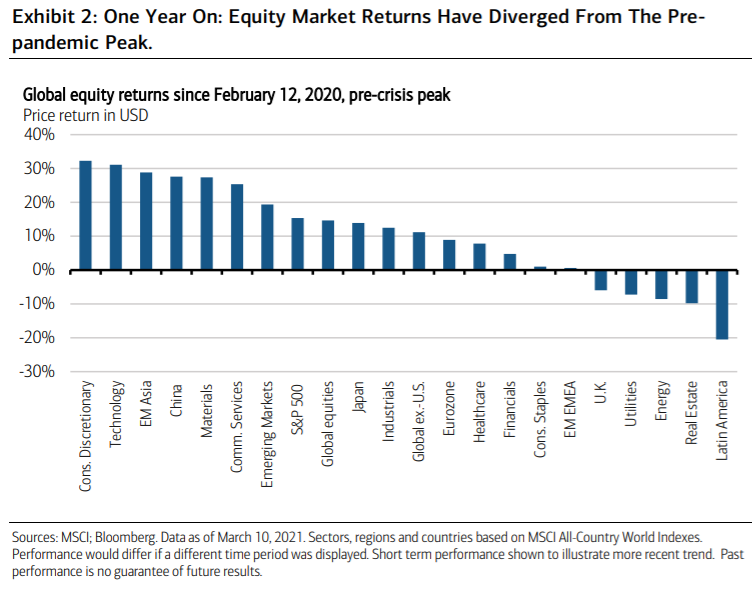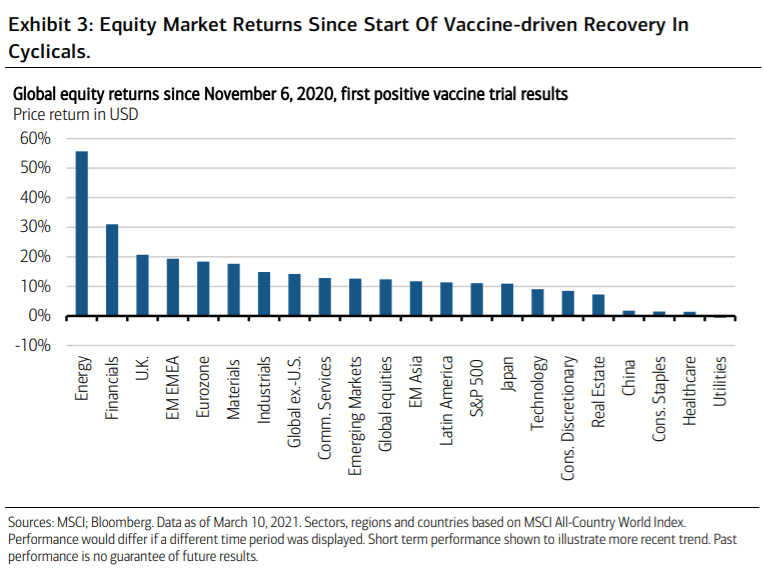Merrill har analyseret det mest dramatiske år siden 30’erne og hæfter sig ved de to vidt forskellige kursudviklingen fra coronakrisens start og fra efteråret med de begyndende vaccinationer. High-tech og onlinevirksomheder havde et forrygende år, men fra efteråret kom de cykliske aktier op, altså de normale aktier, der havde været undertrykt. Men det betyder ikke, at vinderne får nedtur, for digitaliseringen fortsætter. Derfor venter Merrill, at vinderne også vil få fremgang i år, ligesom de cykliske aktier, og Asien vil stadig være et vigtigt investormarked, for dér er væksten uafbrudt.
One Year Later: How Markets Have Moved Since the Start of the
Coronavirus Outbreak
Interest rate-related volatility has been the primary driver of equity markets over recent
weeks. But as we cross the 12-month mark since widespread shutdowns first brought large
segments of the global economy to a virtual standstill in mid-March of last year, it is worth
looking back at how equities have moved over the course of the pandemic so far.
The past year has been a historic period for investors, who have faced not only a once-in-acentury public health crisis, but also the deepest (-10.0%) peak-to-trough contraction in
world GDP and the fastest (21 trading days to reach a 20% decline) global equity bear
market in post-war history.
But one year later, following aggressive monetary intervention by
central banks, trillions of dollars in global fiscal support, and a major reconfiguration in the
behavioral patterns of households and businesses, markets have made significant aggregate
gains. As of March 10, 2021, the MSCI All-Country World Index stood 14.7% above its prepandemic peak, though returns have been widely dispersed across individual sectors, regions
and countries.
Consumer Discretionary and Information Technology have been the leading sectors of the
past year as dependence on internet services has increased with the need for physical
distancing. Emerging Asia—led by China and other north Asian markets that limited the
spread of their local outbreaks by responding quickly in the initial stages of the
pandemic—has been the top-performing region. And the digital economy-oriented U.S.
market has outperformed International Developed, particularly developed Europe, which
has much lower exposure to related sectors such as Information Technology and
Communication Services. At the tail end of the return distribution meanwhile have been
the Energy sector, Real Estate and Latin America as markets geared to travel, hospitality
and natural resources.

This 12-month snapshot of course masks the more recent rotation that began in early
November of last year. The November 9 release of the first successful trial results on the
coronavirus vaccine efficacy began a shift into many of the pandemic laggards, which was
reinforced by similar announcements from other leading pharmaceutical companies over
the following weeks.
Since this period, cyclical sectors such as Energy and Financials have
continued to benefit from regulatory approvals and now the first disbursements of the
new vaccines as investors look ahead to economic reopening in more economies around
the world later in 2021. And most recently, rising inflation expectations and the current
runup in global bond yields have only provided an additional relative tailwind for the
markets most beaten down by the pandemic.
Over the past four months, Energy and Financials have led all other global sectors, Latin America has outperformed China, and non-U.S. markets have outperformed the S&P 500, particularly Western Europe and emerging EMEA (Europe, Middle East and Africa), which have some of the highest regional concentrations within the cyclical sectors.

We expect this relative shift in sector returns to likely persist as global growth recovers
and global interest rates move higher. But technology-related segments and emerging
Asia have nonetheless been able to keep pace with the broader market advance of recent
months, even as investors anticipate normalization in the most depressed segments of the
global economy from the second half of 2021. And as we look further ahead into the
current decade, these growth leaders of the past 12 months across sectors, regions and
countries could also be able to perform well alongside better returns across more cyclical
segments.
A post-coronavirus world should bring forward the expansion of the digital economy as a
greater portion of healthcare, education, retail, entertainment and other services are
delivered remotely. This in turn will likely boost demand for cloud-based software services,
and increase the need for upgrades to supporting infrastructure and hardware such as
high-speed telecommunications networks and advanced semiconductors for data
processing and storage. As online activity commands a larger share of global output over
the years ahead, these improvements in network reliability, speed and capacity will be
critical in supporting a larger number of wireless connections consuming ever larger
amounts of data.
Manufacturers are likely to favor more localized, automated and capital-intensive supply
chains, both to reduce costs and to lower dependence on overseas suppliers of
components and finished goods (including medical supplies and pharmaceuticals) in case
of future disruptions. This too should increase demand for electronic equipment,
components and enterprise software, as well as for new production techniques such as
additive manufacturing.
Headwinds may persist for key segments of the real estate market such as retail, office
and hotel as more activity is conducted online and virtually. And though base metals and
other commodities used in the production of low-carbon energy and battery storage may
see increased demand, fossil fuels are also likely to remain under pressure as remote
activity caps mass transportation demand, and as economies around the world look to
reduce their greenhouse gas emissions and ultimately transition to net-zero.
Lower income, natural resource-dependent economies in Latin America, the Middle East and
Africa are therefore likely to account for a relatively small share of global growth, with the
largest increase in the global consumer class expected to come from the Asia-Pacific
region. Per capita incomes across these regions are likely to grow most quickly in markets
that can increase their share of value-added in the expanding digital economy, though
supply chain localization among leading global manufacturers could limit the potential
gains.
Many of these trends predate the outbreak. But moving beyond the past 12 months
and looking through the recent volatility, one of the main legacies of the pandemic is likely
to be an acceleration of these changes as we move deeper into the 2020s.






